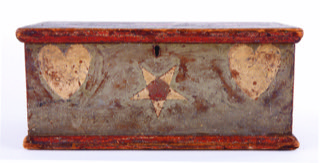By Robin Pridham
The Leask CollectionAuction held November 28, 2020 at Pridham’s Auction House in Ottawa
There is an old saying that we are simply the caretakers of the items and objects we have within our collections. Often purchasing from one collection, where things have been lovingly admired and cared for, sometimes for decades, and then through some form of a sales process, a new caretaker is chosen and the item changes hands. This could be said, and is true for most important collections, no matter what the genre, but there is one area that seems to epitomize this consensus; Canadiana. This includes furniture and objects dating from the very beginning of our existence as a culture on this continent to folk art created in the not-so-distant past. One thing that is for sure, those that participate in this collecting area are passionate about what they buy and, by extension, about our collective history. This sentiment could be epitomized in the recent sale of the “Leask Collection” that took place on Saturday, the 28th of November at Pridham’s Auctions and Appraisals gallery in Ottawa.
Barbara and William Leask curated their collection in the late 70’s and 80’s. It included items ranging from the early 18th century, such as two spectacular French Canadian diamond point pieces of furniture, to a selection of 19th century “Wilno” pieces from Renfrew county, Ontario cupboards, smalls and carvings. Of note was a rare collection of William Loney carvings and paintings, considered the single largest collection of the Prince Edward County native’s work in the country. To round out the sale, included were about 175 lots from a small group of like-minded collectors, which brough the sale catalogue to around 325 lots. As with the Burney sale one year before, Mr. Peter Baker was the lead consultant and catalogue author coordinating with our stellar team of photographers, graphic artists and assistants to assemble one of the finest Canadiana sales to take place in Canada in 2020.
Once the word reached the street as to the quality of the sale, the buzz began to grow and did not dissipate until the last lot was sold! Such a strong interest in almost all the lots was quite remarkable. The Quebec furniture received strong interest from collectors and dealers alike. This was evident in the very strong prices achieved for all the important 18th century masterpieces. There seems to be a silent campaign to repatriate this period furniture and smalls back to where they originated. The fact that Pridham’s is a bilingual house and is well positioned geographically to Quebec is also a contributing factor.
Strong bidding for early pieces was evident throughout the sale with the vast majority of these lots easily meeting the low estimate and often times exceeding. Since the preview lasted an entire week, it provided ample opportunity for people to travel from far-flung regions to view the items they were interested in. There was very limited seating in the gallery, so many chose to either bid online or on the phone. Those that did attend in person, masked up and spaced, added a much-appreciated dynamic to what would have otherwise been a live online only event.
Starting at 10:00 a.m., and being streamed live around the world, a sale of this size should have lasted around 5 or 6 hours, but not this time. Hammering down the last lot at about 7:15 pm, it turned out to be the longest auction in the company’s history, over nine hours. This was largely attributable to the strong and varied competitive bidding. Two bidding platforms, telephones and those present in the room, contributed to one of the most memorable sales in recent history.
I think to summarize this event we might ask what is important in our lives at this time in history. Our culture and the items that represent that culture are as important today as they have ever been. The new caretakers of emerging collections are eager to take up the challenge. They are passionate about preserving our past by caring for our material history. This sale was evidence of that and solidifies the notion that our collective history remains as important today as it has ever been.
Visit pridhams.ca for their upcoming auctions

Sold for : $1,800


Sold for : $9,000

Sold for : $5,700

Sold for : $5,100

Sold for : $7,800

Sold for : $51,000


Sold for : $1,800
